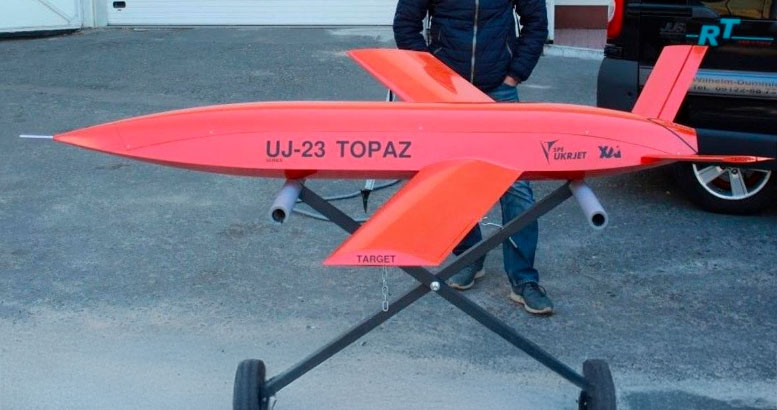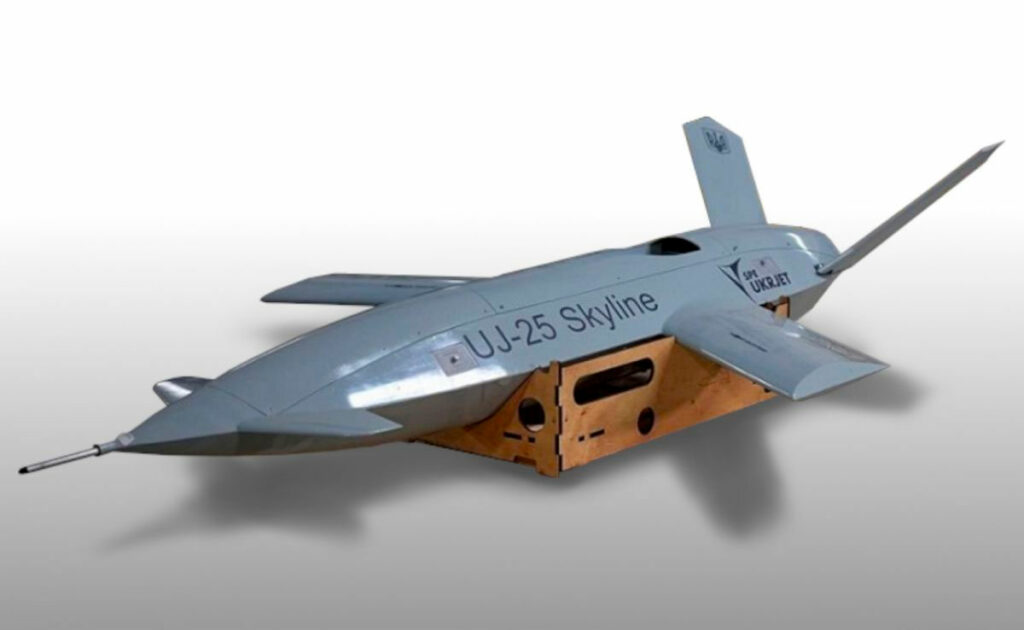Jet-powered Ukrainian loitering munition with 800 km/h max speed, 6,000 m ceiling, and 10 kg warhead; derived from UJ-23 Topaz.
The UKRJET UJ-25 Skyline is a Ukrainian-developed, jet-powered loitering munition designed for precision strikes against stationary ground targets. Derived from the UJ-23 Topaz target drone, it features forward-swept wings, a V-tail configuration, and a top-mounted air intake feeding a rear-mounted turbojet engine. The UJ-25 achieves a maximum speed of 800 km/h (497 mph) and operates at altitudes up to 6,000 meters (19,685 feet). Equipped with a 10 kg (22 lb) explosive warhead, the drone can loiter over target areas before executing a kamikaze-style attack. Its jet propulsion allows for rapid deployment and reduced vulnerability to enemy defenses compared to propeller-driven counterparts. The UJ-25 has been actively utilized by Ukrainian forces since its introduction in late 2023.
History of the Development of the UKRJET UJ-25 Skyline
In the early 2020s, the geopolitical landscape of Eastern Europe was marked by escalating tensions and conflicts, particularly following Russia’s annexation of Crimea in 2014 and the ongoing unrest in Eastern Ukraine. These events underscored the pressing need for advanced military technologies to bolster Ukraine’s defense capabilities. Unmanned Aerial Vehicles (UAVs) emerged as a focal point, offering the potential for reconnaissance, target acquisition, and direct engagement without risking human pilots.
Recognizing the strategic advantages of UAVs, the Ukrainian government and private sector intensified efforts to develop indigenous drone technologies. UKRJET, a prominent Ukrainian aerospace company, had previously developed the UJ-23 Topaz, a jet-powered target drone designed for military training and evaluation purposes. The UJ-23 featured a missile-like fuselage, forward-swept wings, a V-tail configuration, and a top-mounted air intake feeding a rear-positioned turbojet engine. Its performance characteristics included a cruising speed of 600 km/h (373 mph), a maximum speed of 800 km/h (497 mph), and an operational ceiling of 6,000 meters (19,685 feet).
Building upon the UJ-23’s design and capabilities, UKRJET initiated the development of a weaponized variant capable of performing loitering munition roles. This new project aimed to create a UAV that could autonomously loiter over target areas, identify high-value targets, and execute precision strikes by self-destructing upon impact. The objective was to enhance Ukraine’s ability to conduct surgical strikes against critical enemy infrastructure, artillery positions, and armored vehicles, thereby reducing collateral damage and increasing operational effectiveness.
The development program, internally designated as the UJ-25 Skyline, commenced in response to the evolving battlefield requirements and the need for rapid deployment of advanced UAVs. The design retained the core aerodynamic features of the UJ-23 but incorporated modifications to accommodate a 10 kg (22 lb) explosive warhead and advanced guidance systems. Notably, the UJ-25 introduced forward canards to improve maneuverability and stability during loitering and terminal attack phases.
The UJ-25 was first publicly observed in September 2023 during a CNN interview with Mykhailo Fedorov, Ukraine’s Deputy Prime Minister for Innovation, Education, Science, and Technology. In the background of the interview, the UJ-25 was seen, indicating its readiness for operational deployment. citeturn0search2
The UJ-25 Skyline made its combat debut on December 22, 2023, when one of the drones crashed into the roof of a house in the Russian-occupied Ukrainian city of Berdyansk in eastern Zaporizhzhia Oblast. The drone failed to detonate upon impact, providing Russian forces with an intact specimen for analysis.
The rapid development and deployment of the UJ-25 Skyline underscore Ukraine’s commitment to advancing its unmanned combat capabilities in response to contemporary warfare challenges. By leveraging existing technologies and adapting them for combat applications, Ukraine has demonstrated a pragmatic approach to enhancing its military effectiveness.

Design of the UKRJET UJ-25 Skyline
The UKRJET UJ-25 Skyline exhibits a design that reflects its evolution from the UJ-23 Topaz target drone, with specific modifications to fulfill its role as a loitering munition. The airframe features a streamlined, missile-like fuselage constructed primarily from lightweight composite materials, balancing structural integrity with weight efficiency.
The drone’s aerodynamic configuration includes forward-swept wings with clipped tips, contributing to stability and control during high-speed flight. The wingspan measures approximately 3 meters (9.8 feet), providing an optimal balance between lift and maneuverability. The V-tail arrangement, canted outward at an angle of 45 degrees, serves both as horizontal and vertical stabilizers, reducing radar cross-section and enhancing aerodynamic efficiency.
The UJ-25 Skyline features a top-mounted air intake, ensuring efficient airflow to the rear-mounted turbojet engine. This configuration reduces the risk of foreign object ingestion during takeoff and enhances aerodynamic efficiency. The engine exhaust is positioned at the rear of the fuselage, minimizing thermal signature and making the drone less susceptible to infrared tracking by enemy air defense systems.
The landing gear is absent, as the UJ-25 is designed for catapult launch from a rail system or a truck-mounted launcher. Recovery is unnecessary, as the drone is a one-time-use loitering munition that self-destructs upon reaching its target.
For guidance and target acquisition, the UJ-25 employs a combination of GPS-assisted autopilot, electro-optical sensors, and man-in-the-loop control options. This allows for semi-autonomous operation, where the drone can loiter over a target area before the operator selects a point of impact.
Advantages and Drawbacks
The jet propulsion system offers significantly higher speed compared to traditional propeller-driven loitering munitions. This enables the UJ-25 to rapidly close in on targets, reducing enemy reaction time and making interception more challenging. However, the high-speed design limits endurance, as the drone lacks the fuel efficiency of slower, propeller-driven models.
Another advantage is the reduced radar cross-section due to the small size and streamlined airframe, making it difficult for enemy radar to detect and track the drone. However, jet propulsion increases acoustic signature, which can alert ground defenses before impact.
The payload capacity is limited to 10 kg (22 lb) of explosives, making the UJ-25 more suited for precision strikes against lightly armored vehicles, radar stations, and ammunition depots, rather than heavily fortified targets.
Performance of the UKRJET UJ-25 Skyline
Engine and Propulsion
The UJ-25 Skyline is powered by a small turbojet engine, likely an adaptation of the Ivchenko-Progress AI-25TL or a similar low-thrust design. The engine produces an estimated 1.5 kN (337 lbf) of thrust, enabling the drone to reach high speeds while maintaining a compact form factor.
Speed and Altitude
The maximum speed of the UJ-25 is 800 km/h (497 mph), making it significantly faster than most propeller-driven loitering munitions, such as the Iranian Shahed-136, which operates at 185 km/h (115 mph). The cruise speed is around 600 km/h (373 mph), allowing for extended loitering time while maintaining rapid strike capability.
The service ceiling is 6,000 meters (19,685 feet), making it difficult for short-range air defense systems (SHORAD) to intercept. For comparison, the Russian ZALA Lancet loitering munition, widely used in Ukraine, operates at much lower altitudes, making it more vulnerable to countermeasures.
Range and Endurance
The UJ-25 has an estimated operational range of 200 km (124 miles). While this is lower than some propeller-driven loitering munitions, its speed allows it to reach distant targets in a much shorter time.
Comparison with Competing Systems
The UJ-25 Skyline differs from other loitering munitions primarily in its speed and survivability. Most competing drones, such as the Israeli Harop (185 km/h, 115 mph) and the Iranian Shahed-136 (185 km/h, 115 mph), rely on slow speeds and prolonged endurance. The UJ-25 sacrifices endurance for speed, making it more effective in penetrating heavily defended airspace.

Variants of the UKRJET UJ-25 Skyline
UJ-25A
The baseline version designed as a one-way attack drone, armed with a 10 kg (22 lb) explosive warhead and equipped with electro-optical guidance systems.
UJ-25B
An enhanced variant featuring improved loitering capabilities, a larger fuel capacity, and the ability to carry electronic warfare (EW) payloads.
UJ-25C
A reconnaissance-oriented version, equipped with advanced optical and infrared sensors, used for battlefield surveillance and target designation.
Military Use and Combat of the UKRJET UJ-25 Skyline
Armament
The UJ-25 Skyline carries a 10 kg (22 lb) high-explosive warhead, optimized for precision strikes against stationary ground targets. The payload is designed to neutralize enemy radar systems, command centers, and supply depots.
Operational Deployment
The UJ-25 Skyline has been actively used by the Ukrainian Armed Forces since late 2023. Its first known combat deployment occurred on December 22, 2023, when a UJ-25 crashed into a residential building in Berdyansk, a city occupied by Russian forces. The warhead failed to detonate, allowing Russian analysts to examine the intact drone.
In early 2024, multiple reports confirmed the UJ-25 being used against Russian military installations in Zaporizhzhia, Luhansk, and Donetsk regions. The drone has been observed targeting fuel depots, radar sites, and artillery positions.
Combat Effectiveness
The high speed and small size make the UJ-25 difficult to intercept with traditional surface-to-air missile (SAM) systems. Ukrainian forces have used it to bypass Russian air defenses, particularly in heavily contested areas.
The UJ-25 has been compared to the Iranian Shahed-136, widely used by Russia. However, while the Shahed-136 is slow-moving and easy to detect, the UJ-25’s high speed reduces its vulnerability. This allows it to penetrate Russian air defenses with greater success.
International Sales and Operators
Currently, the UJ-25 Skyline is only operated by Ukraine. However, there have been reports suggesting interest from NATO-aligned countries in acquiring the technology for domestic production.
Back to the Drones, UAVs, UCAVs page